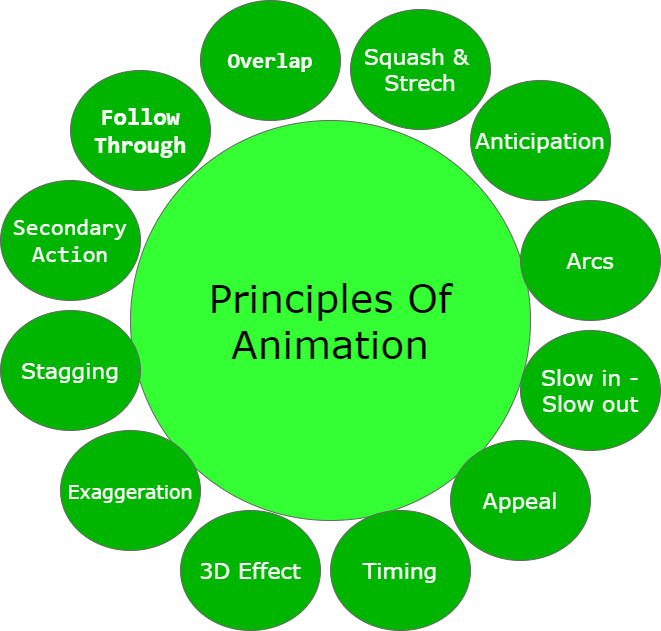Assignment 8 - Animation Principal
Aim: Implement animation principles for any object
Theory:
Animation is defined as a series of images rapidly changing to create an illusion of movement. We replace the previous image with a new image which is a little bit shifted. Animation Industry is having a huge market nowadays. To make an efficacious animation there are some principles to be followed.
Principle of Animation:

There are 12 major principles for an effective and easy to communicate animation.
- Squash and Strech:
This principle works over the physical properties that are expected to change in any process. Ensuring proper squash and stretch makes our animation more convincing.For Example: When we drop a ball from height, there is a change in its physical property. When the ball touches the surface, it bends slightly which should be depicted in animation properly.
- Anticipation:
Anticipation works on action.Animation has broadly divided into 3 phases:1. Preparation phase 2. Movement phase 3. Finish
In Anticipation, we make our audience prepare for action. It helps to make our animation look more realistic.
For Example: Before hitting the ball through the bat, the actions of batsman comes under anticipation. This are those actions in which the batsman prepares for hitting the ball.
- Arcs:
In Reality, humans and animals move in arcs. Introducing the concept of arcs will increase the realism. This principle of animation helps us to implement the realism through projectile motion also.For Example, The movement of the hand of bowler comes under projectile motion while doing bowling.
- Slow in-Slow out:
While performing animation, one should always keep in mind that in reality object takes time to accelerate and slow down. To make our animation look realistic, we should always focus on its slow in and slow out proportion.For Example, It takes time for a vehicle to accelerate when it is started and similarly when it stops it takes time.
- Appeal:
Animation should be appealing to the audience and must be easy to understand. The syntax or font style used should be easily understood and appealing to the audience. Lack of symmetry and complicated design of character should be avoided. - Timing:
Velocity with which object is moving effects animation a lot. The speed should be handled with care in case of animation.
For Example, An fast-moving object can show an energetic person while a slow-moving object can symbolize a lethargic person. The number of frames used in a slowly moving object is less as compared to the fast-moving object.
- 3D Effect:
By giving 3D effects we can make our animation more convincing and effective. In 3D Effect, we convert our object in a 3-dimensional plane i.e., X-Y-Z plane which improves the realism of the object.For Example, a square can give a 2D effect but cube can give a 3D effect which appears more realistic.
- 8. Exaggeration:
Exaggeration deals with the physical features and emotions. In Animation, we represent emotions and feeling in exaggerated form to make it more realistic. If there is more than one element in a scene then it is necessary to make a balance between various exaggerated elements to avoid conflicts. - Stagging:
Stagging is defined as the presentation of the primary idea, mood or action. It should always be in presentable and easy to manner. The purpose of defining principle is to avoid unnecessary details and focus on important features only. The primary idea should always be clear and unambiguous. - Secondary Action:
Secondary actions are more important than primary action as they represent the animation as a whole. Secondary actions support the primary or main idea.For Example, A person drinking a hot tea, then his facial expressions, movement of hands, etc comes under the secondary actions.
- Follow Through:
It refers to the action which continues to move even after the completion of action. This type of action helps in the generation of more idealistic animations.For Example: Even after throwing a ball, the movement of hands continues.
- Overlap:
It deals with the nature in which before ending the first action, the second action starts.For Example: Consider a situation when we are drinking Tea from the right hand and holding a sandwich in the left hand. While drinking a tea, our left-hand start showing movement towards the mouth which shows the interference of the second action before the end of the first action.
Reference of Theory: https://www.geeksforgeeks.org/principles-of-animation/
CODE
#include <iostream>
#include <math.h>
#include <time.h>
#include <GL/glut.h>
using namespace std;
int x=0;
int flag=0;
void init(){
glClearColor(1.0,1.0,1.0,0.0);
glMatrixMode(GL_PROJECTION);
gluOrtho2D(0,640,0,480);
}
void object1(){
glClear(GL_COLOR_BUFFER_BIT);
glColor3f(1,0,0);
glBegin(GL_POLYGON);
glVertex2i(x,220);
glVertex2i(x+40,220);
glVertex2i(x+40,260);
glVertex2i(x,260);
glEnd();
glutSwapBuffers();
}
void timer(int){
glutPostRedisplay();
glutTimerFunc(1000/60,timer,0);
if(flag == 0){
x = x+3;
}
if(flag == 1){
x = x-3;
}
if(x==600){
flag = 1;
}
if(x == 0){
flag = 0;
}
}
int main(int argc, char** argv){
glutInit(&argc, argv);
glutInitDisplayMode(GLUT_DOUBLE | GLUT_RGB);
glutInitWindowSize(640,480);
glutInitWindowPosition(200,200);
glutCreateWindow("Animation");
init();
glutDisplayFunc(object1);
glutTimerFunc(1000,timer,0);
glutMainLoop();
return 0;
}OUTPUT
FAQ
1. Write 12 Animation Principal
2. Why Anmation?
3. Write Name of Shading Algorithms.
Comments
Post a Comment